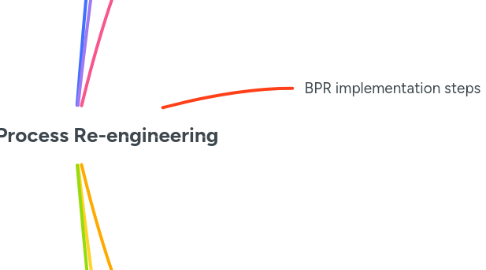Business Process Re-engineering
by Alina Irfan


1. The radical design of core business processes to achieve dramatic improvements in productivity, quality and cycle times
2. Common issues that warrant process reengineering
2.1. Rise is customer complaints
2.2. Rise in refund requests
2.3. Increase in staff stress, disputes and turnover
2.4. Disruptions in business operations after experienced employees quit or go on long leave
2.5. Rapid falling profitability
2.6. Frequent disuptions in cashflow
2.7. Raising inventory levels
2.8. Inability to fill customer orders on time
2.9. Closure of accounts books takes long
2.10. Sales leads are not being followed quickly
3. The main objectives of BPR
3.1. Reduce business costs and process times drastically by eliminating unproductive activities and freeing the employees who perform them
3.2. Improve the quality of customer service significantly by establishing clear ownership of individual tasks. This way employees are made aware of their output and can measure their performance based on process feedback
3.3. Reinvent the basic rules of the business to reduce resource and time wastage, and also keep up with the evolving market and business needs
3.4. Improved customer satisfaction through more efficient business processes for improved producivity
3.5. Enhanced effectiveness of organizational learning by creating new learning opportunities for employees
4. BPR implementation steps
4.1. Maps the current state of your business processes
4.2. Analyze them and find any process gaps ir disconnects
4.3. Look for opportunities and validate them; check if all steps are absolutely necessary
4.4. Design a cutting-edge future-state process map; designate KPI for every step of the process
4.5. Implement future state changes and be mindful of dependencies
4.5.1. Inform every stakeholder of the new process
4.5.2. Only proceed after everyone is on board and eductaed about how the new porcess works
4.5.3. Constantly monitor the KPIs
5. Challenges
5.1. Lack of knowledge creates a great scope for confusion, redundance and repitition is greater, wastage. To avoid this teams must be properly trained ang guided through the implementation
5.2. Does not give instant competitive advantage, rather a thorough process is to be followed. Also not a one-off implemenatation, but must be made part of the business strategy for continuous improvements
5.3. Improper team formulation; need to be well-defined, well structured, have knowledge of operation and process management and the right set of business process knowledge and expertise.
5.4. Lack of essential resources like
5.4.1. Skilled HR
5.4.2. Adequate budgeting/funding
5.4.3. Knowledge of BPR tools
5.4.4. Availability
5.4.5. Timely approval
5.4.6. Correct set of BPR tools
